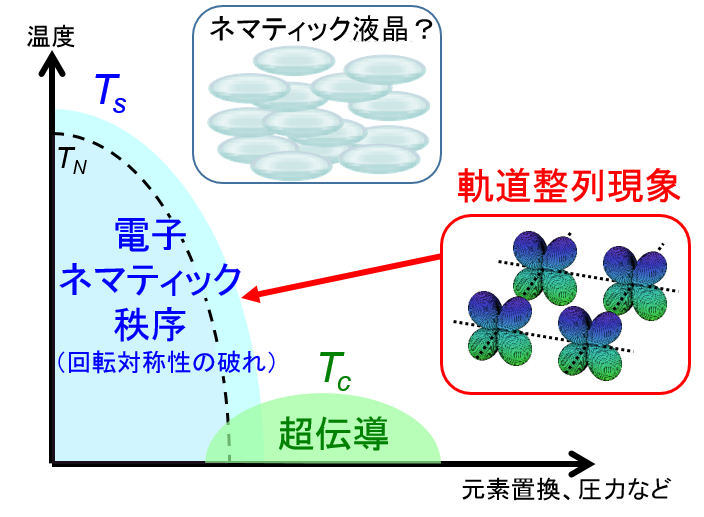Unconventional Superconductivity
Orbital Fluctuation Mechanism in Fe-based Superconductors

Phase diagram of Fe-based superconductors.
In FeSe, no magnetic order emerges in the nematic
state below TS. The compound-dependence of the
phase diagrams is naturally explained by considering
the Aslamasov-Larkin vertex corrections.
Fe-based superconductors, which was discovered in 2008, exhibit high-Tc next to the cuprate superconductors. After thediscovery, lots of researched have been performed for these hogh-Tc superconductors all over the world. To solve important unsolved issues, we have focused on the many-body effect beyond the mean-field-type approximations, called the vertex corrections.
In Fe-based superconductors, the conduction electrons acquire d-orbital degrees of freedom, and interesting “orbital physics” emergenear the superconducting phase. We discovered that the electronic nematic transition in Fe-based superconductors, which is the spontaneous rotational symmetry breaking of correlated electrons, originates from the orbital order driven by vertex corrections [1,2]. The strong orbital fluctuations mediate the s-wave SC gap without sign reversal, called the s++ wave state [3,4]. The s++ wave state is supported by the tiny impurity effect on Tc [5] and the resonance-like hump structure in neutron inelastic scattering measurements [6].
Recently, novel electronicproperties in FeSe attract increasing attention. We revealed that the “nonmagnetic nematic state” in FeSe is naturally explained as the orbital order due to the vertex correction [7,8]. The increment of Tc under the pressure (Tc~40K) and heavily electron-doping (~65K) is understood as the orbital fluctuation pairing mechanism.
[1] S. Onari and H. Kontani, Phys. Rev. Lett. 109, 137001 (2012).
[2] H. Kontani and Y. Yamakawa, Phys. Rev. Lett. 113, 047001 (2014).
[3] H. Kontani and S. Onari, Phys. Rev. Lett. 104, 157001 (2010).
[4] S. Onari, Y. Yamakawa, and H. Kontani, Phys. Rev. Lett. 112, 187001 (2014).
[5] S. Onari and H. Kontani, Phys. Rev. Lett. 103, 177001 (2009).
[6] S. Onari, H. Kontani, and M Sato, Phys. Rev. B 81, 060504(R) (2010).
[7] Y. Yamakawa, S. Onari, and H. Kontani, Phys. Rev. X 6, 021032 (2016).
[8] S. Onari, Y. Yamakawa, and H. Kontani, Phys. Rev. Lett. 116, 227001 (2016).
[9] Y. Yamakawa and H. Kontani, Phys. Rev. B 96, 144509 (2017).
[10] Y. Yamakawa and H. Kontani, Phys. Rev. B 96, 045130 (2017).
